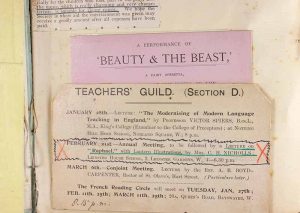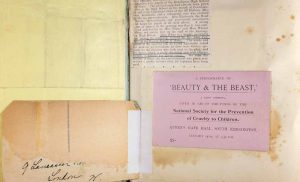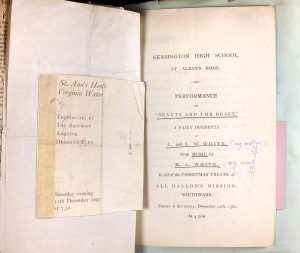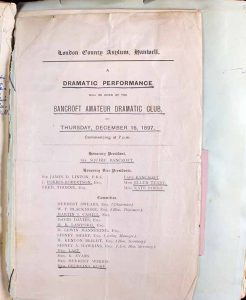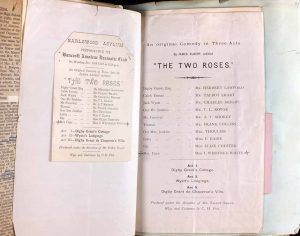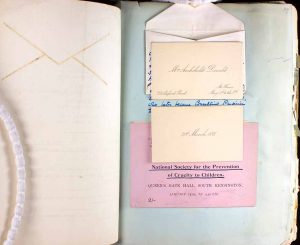My name is Amy and I’m part of the Transforming Archives traineeship, with my specialism being digitisation. I’m based at UCL Institute of Education, Newsam Archive, and I have been working on the White Family collection, of whom three sisters became teachers in the early 1900s. In 1864, Louisa Makin married Robert White and went on to have four daughters; Mary Louisa (Louie); Lucy Winifred (Winnie); Jessie Gertrude; and Agnes Sarah.
Winnie married Charles Henry Nicholls in 1902 and their daughter Agnes Margaret (Poppy) was born in 1907. Winnie worked for the London University matriculation, as a private governess, and then as a form mistress, during which time she trained in elocution at the Guildhall School of Music. Between 1901 and 1917 she taught elocution and history of art at various schools before founding, and becoming head of, The Garden School which she based on the principles of love, freedom, brotherhood, cooperation and service. She was also heavily involved with the New Education Fellowship, which held conferences at the Garden School.
I have been focusing on a scrapbook compiled by Louisa White which contains memorabilia relating to her daughters’ careers.
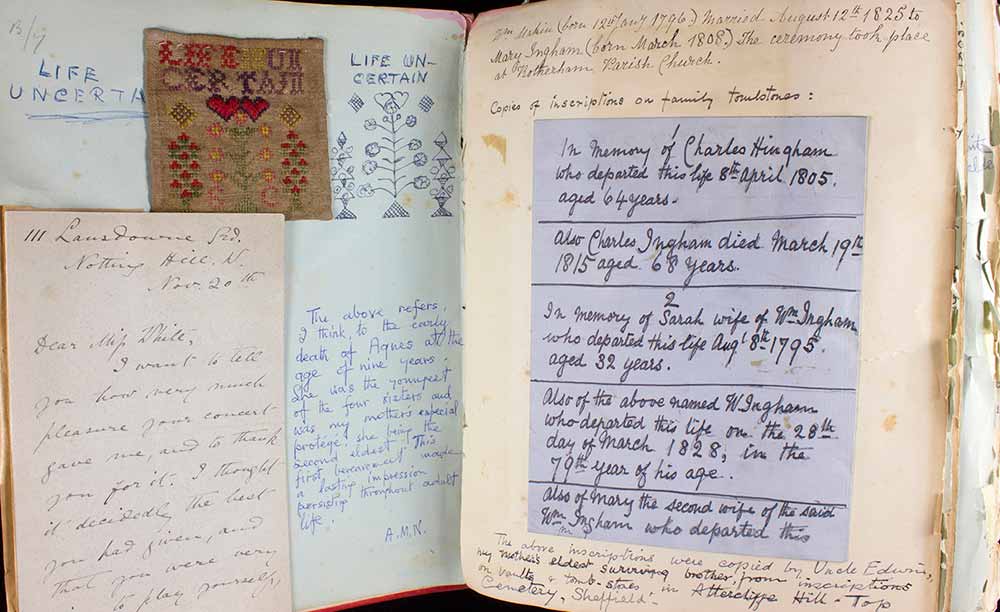
Louisa White’s scrapbook (UCL Institute of Education, Newsam Archive catalogue reference: WEF/3/4)
I have been assessing the digitisation requirements for the scrapbook, taking into consideration the physicality of the book, how to undertake digitisation work, how to process and describe the digital images, as well as the time involved in carrying out such tasks. My recommendations are specific to this scrapbook and the resources available at the Institute of Education. I will briefly outline some of these considerations below but I fully expect to adapt them once testing has been completed.
First to consider is the condition of the item; how stable is it for digitisation? Is any conservation work required prior to digitisation? Upon assessing the external bindings of the book it’s clear the fragility is mainly due to the fabric covering that has replaced the spine of the original binding. The original stitching is coming apart resulting in loose and torn pages, which are likely made worse by the weight of the additional items pulling at the stitching. It is clear that booklets have been inserted between pages using long stitches, possibly done at the time the spine was replaced.
- Example of foxing and acidic card causing damage to paper beneath (catalogue reference: WEF/3/4 )
- Example of foxing and acidic card causing damage to paper beneath (catalogue reference: WEF/3/4 )
Conservation and care of this item will be difficult due to the mixture of materials involved. There is evidence of foxing on pages and some items inserted into the scrapbook have caused damage to facing pages due to their acidic content. Ideally there needs to be acid-free paper between the pages to act as a barrier to prevent further damage but this will put pressure on the already fragile spine. The book could also be stored in a tailored archive box to prevent the page edges from being damaged further.
The next consideration would be the contents of the scrapbook which include a mixture of photographs, programmes (some painted), letters, sewing, illustrations, prayers, a lock of hair, and cards. Louisa, Winnie (daughter) and Poppy (granddaughter) wrote annotations throughout; these are usually found alongside items but also appear within the text of an article or programme. There is also a letter that has been written on very thin paper, the ink has faded which means the words are hard to discern. Digitising this would mean that the writing could be recorded before the ink fades even more; it would be an easy process as the letter is a loose insert, but the thinness of the paper means it is quite fragile.
The gallery below gives an example of the number of items attached to just one page in the scrapbook, demonstrating the complex referencing required to identity each item and their placement in the book.
- One page of the scrapbook (catalogue reference: WEF/3/4)
- One page of the scrapbook (catalogue reference: WEF/3/4)
- One page of the scrapbook (catalogue reference: WEF/3/4)
- One page of the scrapbook (catalogue reference: WEF/3/4)
- One page of the scrapbook (catalogue reference: WEF/3/4)
Listing the content and visual description for each item on each page would be a good task for a volunteer. It would provide a richer catalogue description of the scrapbook and based on this content, an informed decision can be made regarding the value of digitising it. Will the item and its contents be used regularly by readers to make the whole digitisation process worthwhile? It may be more efficient to only digitise the items or pages that are most informative or those that are most fragile.
Once the condition and digitisation requirements of the book have been assessed, the digitisation equipment, settings and arrangement are to be planned accordingly. Due to the condition of the spine, the book cannot lie flat and therefore digitisation via scanning is not an option, unless there are loose items whose condition is stable enough to be scanned. As a result, book supports are required and the camera will need to be positioned at angle to ensure it is parallel to the page. As the Institute of Education has one camera it will be necessary to photograph all recto sides followed by verso sides.
With regards to the content, an image of the page as a whole would give context to the arrangement and any related annotations. However, items will need to be considered individually. A common example is the folded letters glued in the book. Photographs will need to be taken of items while folded and unfolded. Many items have writing on all sides so they have been glued into the book in a way that allows the writing underneath to be read; however it is not possible to digitise this without damaging the item. The use of OCR technology would be beneficial for reading articles of text but it is unable to discern handwritten notes. Therefore, its use will need to be tested to determine whether the handwriting interferes with the speed and quality of text recognition. Nonetheless a volunteer could transcribe the written notations to make the files searchable.
The identification of specific page numbers, sides, items and item sides needs to be listed in the catalogue and the metadata of digital files. This will ensure that the digital data related to the scrapbook (images, metadata and catalogue entry) are linked together with the physical archive item. If applicable, copyright holders will need to be identified due to the presence of works by newspapers and photographic companies. The next step would be to thoroughly test these recommendations by working on several pages of varying complexity. The results will ensure that estimations of duration, complexity and costs are reliable.
